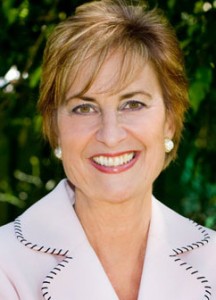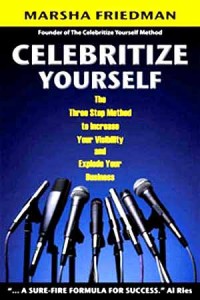 MEET Marsha Friedman: As an innovative and focused entrepreneur, Marsha Friedman has successfully managed EMSI Public Relations for more than 20 years. Clients EMSI Public Relations has represented include The Temptations, Sergeant’s Pet Care Products and former National Security Advisor, Robert McFarlane. In addition to owning a company, Marsha serves clients as a professional public speaker. She is also the author of the books Celebritize Yourself: The Three Step Method to Increasing Your Profile and Exploding Your Business. Active in the community, Marsha is the founder of Cherish the Children Foundation. You can connect with her on the radio during her national show, “The Family Roundtable” where she has interviewed guests like hit singer, Faith Evans, actress Vicki Lawrence, actor Tony Curtis, Rose Rock and Janine Turner. She is online at http://marshafriedman.com
MEET Marsha Friedman: As an innovative and focused entrepreneur, Marsha Friedman has successfully managed EMSI Public Relations for more than 20 years. Clients EMSI Public Relations has represented include The Temptations, Sergeant’s Pet Care Products and former National Security Advisor, Robert McFarlane. In addition to owning a company, Marsha serves clients as a professional public speaker. She is also the author of the books Celebritize Yourself: The Three Step Method to Increasing Your Profile and Exploding Your Business. Active in the community, Marsha is the founder of Cherish the Children Foundation. You can connect with her on the radio during her national show, “The Family Roundtable” where she has interviewed guests like hit singer, Faith Evans, actress Vicki Lawrence, actor Tony Curtis, Rose Rock and Janine Turner. She is online at http://marshafriedman.com
WMI: As a little girl were you drawn to business? If not, what did you, as a child, dream of becoming?
MF: What I knew as a child was that I wanted to help people. The earliest remembrance I have is when I was about five years old. I had saved up $1.00 to give to my school bus driver when I learned it was her birthday. It meant a lot to me to be able to give it to her, but of course, as much as she loved my gesture, she couldn’t accept my gift. I believe that our lives’ basic purpose is defined when we’re as young as two to five years old. As I look back at that moment in my life, I see a curiosity and caring for people and a desire to help them; it has been a guiding light in my career path.
WMI: When and why did you found EMSI?
MF: I started my company in 1990. In fact, we just celebrated our 22nd anniversary. As to why I started EMSI? In my early 20s, after being in the workforce for three or four years, I knew I was an entrepreneur at heart and wanted my own business. I started my first business at 21 – a coffee house (Greenwich Village type) on the beach in Venice, California and realized I loved being at the helm. When I moved to Florida in 1989, I went to work for a publishing company handling media for the CEO and discovered I would never be happy working for someone else. A good friend who was a brilliant marketer suggested the idea of pay-for-performance publicity, which was a unique concept in 1990 – and the idea resonated with me. That’s how it all began.
WMI: Let’s talk about media analysis. What’s included in the analysis and what benefits are derived from a media analysis that are not gained through market research alone?
MF: As PR professionals, we serve two clients. First are those who pay us to represent them to the media and second is the media, which views us as a content provider. In order to be effective on both counts, it’s critical that we follow the news. Every member of our team does that in his or her own way. We have a big-screen TV in our conference room and it’s tuned to CNN all day so we know what’s going on at all times. This constant alertness to news and trends is critical for identifying opportunities to link our clients to timely issues related to their message. We pitch them as experts who can comment on news issues or provide valuable information to consumers. Our success, and theirs, depends on our knowledge of the news.
WMI: At the official EMSI it states, “With EMSI, PR is not a gamble. It’s a guarantee.” What about your marketing results allows you to say this?
MF: We’re able to say this because all of our services come with a guarantee of media exposure. To understand how we’re different from most PR agencies, it’s important to know that the standard in the PR industry is for clients to pay a monthly retainer fee. There is no guarantee of any media coverage, only the agency’s best efforts. This isn’t meant in any way as a negative comment about my associates, as many agencies get great results. I just structured my company differently because as a marketer, I knew I needed a competitive edge. So, our clients don’t pay us a monthly retainer. Instead, we have a set fee for each radio and TV appearance we arrange and a flat fee for print coverage with a guarantee of placements.
WMI: It’s a fact that appearing on television and radio, in print (e.g. magazines, newspapers) and on major websites like Black Enterprise, Forbes and TechCrunch can create consumer familiarity for creative business leaders who are featured or interviewed at these outlets. However, consumer familiarity does not always translate into consumer trust or product/service sales. Based on your working experience, what two to three action steps can creative business leaders incorporate into their marketing and promotion strategies to build consumer trust and, more importantly, increase sales?
MF: 1) There is nothing that can build trust as effectively as appearing as a guest on radio or TV, or being quoted in the press. The implicit endorsement this brings is absolutely priceless. So, a critical step in any marketing strategy MUST include the use of the media, which will position you as an expert in your field. The public understands that the media vets their guests, so if you’re featured in the news as an expert, you must be one!
2) Once you have the media coverage, think of it as “Marketing Gold!” You’ve earned bragging rights, so use them. Take every opportunity to share it with your business associates, clients, prospective clients, your social media connections; post it prominently on your website or blog for visitors to see. It’s a way to re-purpose your media to strengthen your positioning as THE credentialed expert in your field. Of course, when it’s a radio or TV appearance, invite everyone to tune in. There’s something to be said for your clients seeing you in real time on TV or hearing you on a radio show.
3) While publicity builds trust, sales occur at your point of purchase. So, if your point of sale is your website, make sure it has great copy to engage your visitors and is professionally designed and written to reflect your position as a trusted advisor or expert. To secure great media but have an unprofessional website and conversely, to have a great website but no publicity to drive visitors, is an inefficient use of your time and money. They work hand in hand.
WMI: The temptation to sale-sale-sale during interviews can be hard to overcome for creative business leaders. That said, after you land television and radio interviews for clients do you coach them on what to do (and what not to do) during the interviews? If so, please share with Write Money Inc. readers three to four interview tips you give your clients?
MF:
1. First, and foremost, engage your host! If you can build a good rapport with the host, then you will have engaged his listeners.
2. Prep for each interview. If it’s a radio or TV show, listen or watch it first, if at all possible. You’ll be a lot more comfortable if you know how the host conducts interviews before you go on the air. Also, being relaxed will make for a much better interview.
3. Make sure you have thought through the exact message you want the audience to take away from the interview. If you’re doing a phone interview for radio or print media, keep notes in front of you throughout the interview so you don’t go off message.
4. The media is interested in you providing valuable information for their audience, that’s how they keep their audience tuned in. So in preparing for the interview, think about the problem your expert advice can solve and make sure to cover it in an entertaining way.
If you engage the host and offer valuable advice to the audience, most hosts will do all the promoting for you. And, it’s far better to have someone else, especially an opinion leader, tell others how great you are. Going on the air to pitch your product or company is the surest way to cut short the interview, and you will have lost a great opportunity to be featured on that platform.
 WMI: In your “Why Your Marketing Plan is Like a New Year’s Resolution” article at the EMSI official website, you state, “As with diet and exercise, consistency makes all the difference in marketing and public relations. If you put your marketing plan in a drawer and don’t take time every day to use it by reaching out to your readers, customers or followers, it won’t reach its potential. It takes small steps every day.”
WMI: In your “Why Your Marketing Plan is Like a New Year’s Resolution” article at the EMSI official website, you state, “As with diet and exercise, consistency makes all the difference in marketing and public relations. If you put your marketing plan in a drawer and don’t take time every day to use it by reaching out to your readers, customers or followers, it won’t reach its potential. It takes small steps every day.”
Then you contrast the marketing power at large firms with that at smaller firms, including the fact that creative business leaders at small firms may handle business logistics (e.g. designing and patenting new products, creating company newsletters, managing customer service initiatives paying business taxes) single handedly while business leaders at large corporations have armies of employees to handle logistics and marketing efforts for them.
Marsha, creative business leaders at small companies have so much on their plates as it is, can they truly build, manage and measure effective marketing and promoting campaigns too? Why or why not?
MF: My answer is simply, “Can they really afford not to?” Marketing is the foundation of every business, big or small. I saw this definition on Twitter and liked it because it’s a very simple statement of marketing’s function: “Marketing is the art of getting people to want something before they would have come to the same conclusion.” — Guy Kawasaki
Marketing is all about creating “want” in the consumer and that is a never-ending process. You don’t just market for a day, a week, or a year or two. For any company to succeed, the owner needs to understand the importance of reaching out to the public to build customer awareness and visibility. Without it, a business will shrink. The best CEOs are the ones who understand the importance of marketing and are marketers themselves. They realize that when the business is down trending, the answer may be to cut expenses everywhere EXCEPT marketing. It’s the most critical area to invest your time, money and effort in as that investment, when done correctly, is the only thing that will turn a company around. Without effective marketing you have no customers and no sales.
WMI: Do you have a team of marketing and public relations professionals that you work with at EMSI? In what ways does your team strengthen EMSI’s platform and expand its reach?
MF: The members of my team who work with the media are mostly all former media professionals. For example, my Senior Campaign Manager came to us with 15 years experience as a national talk radio host. My TV Campaign Manager was an on-air TV anchor and executive producer for years. My Creative Director is an award-winning journalist who spent 30 years at a major daily paper as a features writer and senior editor.
It took me awhile to realize that my best employees were those who have worked on the other side of the media. They got pitched all day long by PR agencies. As former hosts, producers and journalists, they know which pitches got their attention and, more importantly, why. Consequently, they know what the media is looking for and can provide that for our clients. Their professional experience enables us to get some great media coverage for our clients, month in and month out.
WMI: Please share a favorite client PR success story with us.
MF: Being in business for over 22 years, there are many wonderful client stories I can share, but one of my favorites is that of a client who came to us with a book she had written that was a memoir. This woman had experienced more trauma in her lifetime than 10 people put together. When she was a teenager, her father was murdered. Not only did she lose her beloved dad, her family went from being fabulously wealthy to having no money at all. In later years, she wound up in an abusive marriage and to top it all off, she was diagnosed with throat cancer. She was near death and was told that if she survived, she would never speak again.
But, this woman had a spirit that wouldn’t die. She pulled through it all – left the abusive husband, survived the surgery and chemo, and didn’t lose her voice. She married a loving man who is devoted to her survival. Her book was her story.
When we finally met, she told me of her dream to have her own TV show and asked me if I thought it was possible. I told her, based on everything she had already survived and accomplished, I truly thought anything was possible. She had the passion for it, the guts to do it and the skill from her training as a performer. This casual discussion took place over lunch, when she came to town to be interviewed on a national TV show.
We got her wonderful media coverage, which kept her dream alive because she saw how her message resonated with people. I later learned that she credits my belief in her and my words of encouragement for her now having her own TV show in a major market. It recently won some very prestigious awards.
This is my favorite client story, because it’s so rewarding to me personally. When, I’m able to contribute to my clients’ passions and dreams, I feel gratified and so thankful to have been able to play a role in their happiness. This is why I love what I do!
WMI: I love your newsletter. When did you create it and how has it helped you to engage prospective clients more fully?
MF: I started the newsletter in one form or another about 15 years ago. It was out of necessity because at that time, I was the overwhelmed executive who had to not only find the customers (the hardest job) and then close them on buying our service, I also had to oversee hiring, firing and financial matters. As I was absolutely horrible at making cold calls, I got smart about writing pieces that would get people to call me!
While I wasn’t educated as a marketer, I had an affinity and basic understanding of the subject. I knew if I could find a way to stay in front of prospective clients about my company, they would call and I could convert some to customers. But, I also knew that if I mailed them a letter, sent them a fax (I’m aging myself here!) or emailed them, the only way they would read what I sent is if I provided them with information they could use. It’s really an important strategy for almost every business to consider, especially service businesses. And, that’s where the importance of an opt-in list is so crucial, so you can stay in front of prospective clients with valuable information.
As my company got older, we got more experience and our knowledge base expanded, so our information just got better and better. Now, I find people that share my newsletter with others and ask me to contribute to their publications and blogs, as I’m doing for you right now! The growth of our database and expansion of our newsletter has made my company more well known, and well thought of, and has become our biggest marketing asset.
WMI: What’s next for Marsha Friedman and EMSI? Where do you see yourself and your company three to five years from now?
MF: In three to five years I’d like to comfortably squeeze a lot more employees into our new digs in Wesley Chapel. I’d like to have helped fulfill so many more clients’ dreams; I could tell their stories for years. I’d like my new radio show to be off the charts, and lastly, I’d like to get into the bikini I wore 20 years ago!
If you enjoyed or benefitted from this article, share it with others by clicking the Twitter, Facebook, LinkedIn, Google Plus and Share buttons below. You bet! We appreciate it!
Enjoy exploring the rest of our site, reading and learning from our articles.
Get Your Copy of Long Walk Up at https://www.ebookit.com/books/0000000531/Long-Walk-Up.html




You must be logged in to post a comment.